When we first started researching the magical world of mushroom spores, we were shocked to find so many markets selling psychedelic spores freely on the web.
Mushrooms containing psychedelic compounds like psilocybin are not only illegal, they're a Schedule I substance under the Controlled Substances Act.
If magic mushrooms are illegal, why are their spores so freely available to buy?
How can these legal microscopic spores turn into mushrooms capable of delivering magical experiences? And how can you cultivate them in your own home?
Keep reading to find out in this in-depth guide to magic mushroom spores.
What are magic mushroom spores?
Magic mushroom spores are the microscopic structures that these fungi use to reproduce. In nature, they disperse via wind, allowing mushrooms to colonize tasty new growing spots. You can think of spores as “mushroom seeds,” although they are very different biologically!
Each variety of magic mushroom has its very own spore.
There are over 200 known varieties of magic mushroom spores, with some of the most popular types including:
- Golden Teacher mushrooms, named for their golden color
- Penis Envy mushrooms, which exhibit a…recognizable…shape (and extreme potency)
- Amazonian mushrooms, known as a well-balanced choice
Are magic mushroom spores legal?
Magic mushroom spores do not actually contain any of the controlled substance psilocybin (the chemical that imbues magic mushrooms with their potency). For this reason, magic mushroom spores are perfectly legal for educational purposes, microscopic examination, and identification. The mushroom cells simply do not begin making this chemical until after spores have germinated.
Please check your local and state ordinances for information on whether mushroom spores and mushroom germination are illegal. It's likely that they are.
Once mushroom spores germinate and begin producing mycelium, the thin thread-like structures that function as the “roots” of mushrooms, only then will they begin producing psilocybin.
That’s why perfectly legal spores can grow into mushrooms that will be illegal in many states.
Because of the widely varying legal status of magic mushrooms, we recommend being cautious and doing your research. We painstakingly assembled a 50-state database of the legality of magic mushrooms which you can find here.
The types of magic mushroom spore products
Because magic mushroom spores are legal (see above) they can be purchased online through commercial retailers. Spores are likely to be sold through one of two common methods.
- Syringe Method: a syringe containing living mushroom spores that are ready to go, suspended in a solution such as a honey liquid culture. This method is convenient for colonization and may promote faster growing times, but has a limited shelf life (though shelf-life can be improved if the syringes are kept in the refrigerator).
- Print Method: spores that have been deposited onto a material such as paper. While perhaps less convenient for cultivation than pre-assembled syringes, spore papers can be easily stored in a ziplock bag and represent a cheap, room-temperature storage medium that can last decades.
Either way can work great for selling, transporting, and germinating healthy, viable spores. But no matter what, you will need some foundational knowledge about growing mushrooms if you hope to nurture these spores into something magical.
What to look for in a magic mushroom spore provider
You can certainly buy high-quality, safe, legal magic mushroom spores online! But we recommend conducting some due diligence. Spores sold online are not regulated, scams are a real risk, and not all spores are what they seem!
At best, bad spores will simply fail to grow (or grow into a fungus that isn’t magic at all).
At worst, they may harbor contaminants that could harm your health.
These warnings are not meant to scare you off from buying spores online. But like any product that may enter our bodies, it's important to take some common-sense safety precautions!
So how can you find a reputable seller who offers quality magic mushroom spores? These factors are a great place to start:
- Marketplace Reputation: the good news is, magic mushroom cultivation is popular! Many other experienced users can help you with their experiences. A little searching on some popular cultivation forums will provide some valuable leads and is a great way to weed out scams. We provide a few suggestions below.
- Commercial Intent: is a seller offering packages of spores for microscopy or scientific purposes? This is a sign that they are providing quality, legal, safe spores.
- Product Quality and Reviews: many forums and websites provide online reviews. Pay particular attention to any reports of inert, moldy, or contaminated products, a sure sign of lacking quality control.
Top-rated places to buy magic mushroom spores
If you want a head start on your research, our team has already spent time scouring the internet, using the best practices above to identify some of the most well-regarded options for purchasing magic mushrooms spores legally online. These are all great places to start your search:
- Shroomery.net
Below, we list some of the most reputable sellers uncovered by our research. But if you prefer to take a deep dive into an active magic mushroom cultivation community, it’s hard to imagine a more useful place than Shroomery.net. In addition to a wide variety of tips, you will find regularly updated lists of trusted spore cultivators. - Ralphsters Spores
You will find that Ralphsters Spores is widely recommended in mushroom growing communities, forums, and social media discussions. They offer spores using both the syringe and print method. They do ship worldwide but only offer payment by mail. - Spores101
Spores101 is another choice that has consistent online reviews and a reputation for quality. They offer shipping to the US and Canada, digital payment, 48-hour shipping times, and full package tracking and insurance. - Sporeworks
Another popular choice, Sporeworks offers a wide variety of strains in both syringe and print formats. While they only ship within the United States, they accept a variety of payment methods and ship spores in under a week. - /r/SporeTraders
Another option for a lively community full of trusted seller recommendations, reviews, discussions, and more, this subreddit is a great place to add to your list when researching strains or cultivators.
How to cultivate shrooms with the monotub method
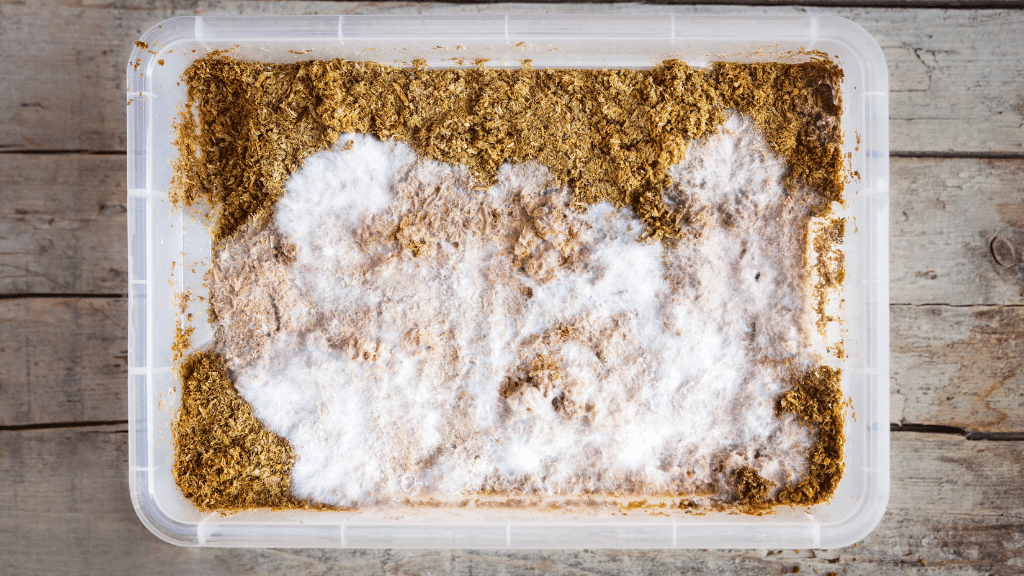
Magic mushroom enthusiasts have been refining DIY methods for cultivating spores into potent fungus for years (at least 1975). This Wired article provides a fascinating look at the history of DIY mushroom cultivation, its legendary place in early internet culture, and how early techniques have been refined into those most commonly used today.
While there are many viable methods, we outline one of the most popular for casual home cultivators, the monotub method, below.
What do you need to grow shrooms with a monotub?
This method is commonly recommended to beginners because it doesn’t require a large investment in equipment to be successful, is relatively simple, and can fit into a variety of different home spaces. But it can still provide excellent harvests!
Magic mushrooms grow naturally in moist, nutrient-rich areas like rotting logs or a nice little pile of cow manure. The goal is to replicate this moisture- and nutrient-rich environment without allowing for contamination by mold or bacteria (we provide more in-depth information on how long mushrooms keep, and tell-tale signs of contamination, in our article here).
In short, a plastic “monotub,” filled with a nutrient-rich substrate layer, will help keep humidity levels high while still allowing for some air exchange.
Must-have supplies include:
- Mushroom spores
- A large plastic tub. You can purchase a purpose-built cultivation tub online or make one yourself
- Micropore tape
- A pot and/or pressure cooker
- Vermiculite
- Cow manure, brown rice flour, and/or alternative nutrient additives (see below)
- Mason jars with lids
Monotub method: the growing steps
Many different online guides go into incredible depth on virtually every step related to mushroom cultivation. And we certainly recommend doing your own research. But it can also be easy to get lost in the weeds of finding the “perfect choice” (something many successful mushroom growers can’t even agree on).
With that in mind, the steps below are meant to illustrate how relatively simple it can be to grow your very own magic mushrooms!
Along the way, here’s the most important tip: sterilize, sterilize, sterilize.
The nutrients and moisture that help mushrooms grow are also like a magnet to bacteria and mold, and this whole process is designed to allow for moisture and airflow while keeping these unwanted guests out!
The best thing you can do to help is sterilize all of your tools along the way.
Boiling or pressure cooking are go-to options, while alcohol wipes are a great choice for wiping down the tub itself.
1. Spawn your spores
You will want your spores to spawn into healthy mycelium, typically grown in a sterilized grain mixture, before the monotub process itself begins. A classic method is using about 8 16 oz. mason jars with lids.
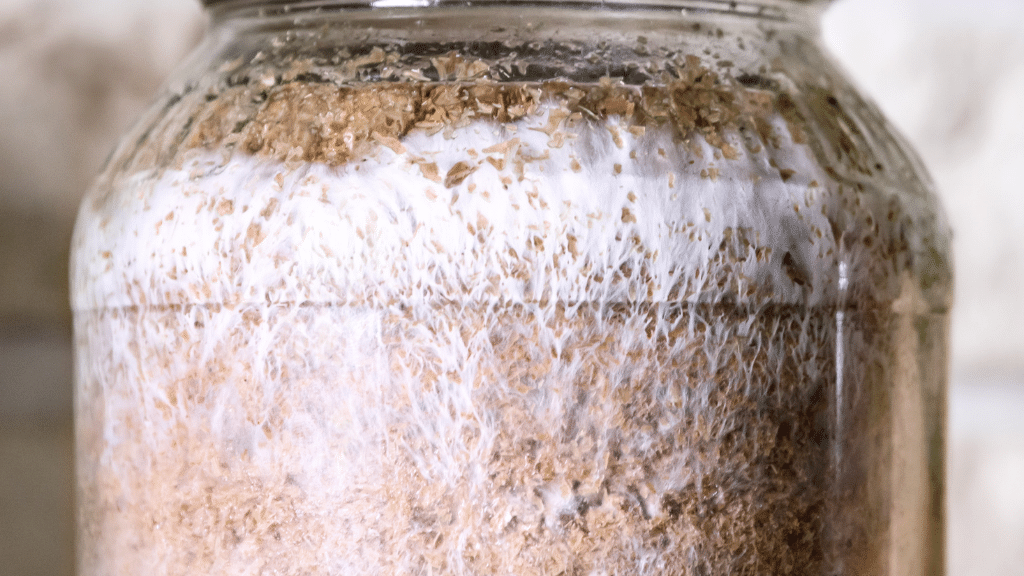
There are a lot of sterilized substrate companies out there. But we really love the product quality and reliability of North Spore based in Maine.
First, hydrate the grain by adding it to a pot of water brought to a boil. Soak for about an hour until the grain can be easily crushed in your fingers. You want to create an easy-to-digest mixture for your spores! Next drain the grain (it can still be damp).
Second, pack the mixture into mason jars and cover each jar with aluminum foil. Then, sterilize the jars using either a pressure cooker (ideal) or partial submersion in boiling water. Using a pressure cooker can be intimidating. But fear not, it's easier than you think.
Here's a great video on how to sterilize with a pressure cooker if it's your first time:
The final step is to inoculate this mixture with your spores.
This is a key step where preventing contamination risk is essential!
Ideally, work in a small enclosed space like a bathroom. One great method is to poke a syringe through a tiny hole in the aluminum foil layer to inject spores into each jar, flame sterilizing the needle tip in between.
Now just wait, and watch the mycelium spread! It should take about 2-3 weeks to fully colonize the jars.
When it’s about halfway done, a gentle shake can help distribute the mycelium and improve growth speed.
2. Acquire or make the monotub
If you purchase a pre-made monotub for mushroom cultivation, this step is easy. Here's a review we did of the best monotub home kit out there.
If you chose to make one, first grab:
1. A plastic tub - the size can vary based on your needs as long as it's a sturdy container with a great lid. For reference, a 56 quart container is a good starting size
2. Something to create holes in your container - this can be a screwdriver, a power drill, etc
3. Alcohol wipes (remember, always sterilize everything as contamination can ruin everything!)
4. Opaque contractor or trash bags to line the bottom of the tub with
First sterilize your hands (or wear gloves), your tools, and your materials.
You will want to make two holes (this can be done with a screwdriver, drill, etc.) about ⅓ of the way down each side of the tub. These should be high enough on the tub walls to allow for a layer of substrate at least 3- 5 inches deep. The plastic may crack, but this can be easily fixed with tape!
Some folks recommend running the drill in reverse to help prevent cracking.
Lining the tub with something like a basic black trash bag can simplify clean-up and help to prevent mushrooms from attaching to the side of the container.
PRO TIP: Using monotub hole filters can enable air-flow without allowing foreign spores and contaminants into your tub.
Remember to sterilize your tub and/or lining with alcohol wipes and allow them to dry.
3. Add a sterilized substrate layer
This layer provides the nutrients that your now-germinated spores need in order to grow into something magical.
Your substrate material can vary. It can be made from mixes of a variety of different substances. A popular choice is a mixture of cow manure, vermiculite, and brown rice flour. But cultivation enthusiasts endlessly debate the merits of various alternatives!
The key is combining some rich nutrient sources with something like vermiculite (a potting soil that allows for superior air flow).
This mixture should be placed in a sealed container and either baked or pressure cooked for sterilization prior to the next step.
How to sterilize your mushroom substrate without a pressure cooker.
In order for you to sterilize substrate effectively without a pressure cooker, high temperatures (above 250 degrees) need to be sustained for a very long period of time. A popular method is to 'bake' your substrate in the oven. Put your substrate in an oven-safe container - like a high-wall baking sheet or a dutch oven. Place in the oven at 350 degrees for at least 3 hours.
Once sterilized, the mixture should be spread out evenly along the floor of the tub (but not compacted down).
Remember, wearing sterile gloves or thoroughly washing your hands is recommended at every stage.
If your substrate has dried out during sterilization, adding a bit of moisture back is critical at this stage. Incorporate sterilized water into your mixture until it's just slightly moist, but not wet.
4. Introduce the spawn
Now it’s time to introduce your spawned mycelium! Simply remove the cake of mixture from each jar and place them on top of the substrate layer. Then, cover with a sheet of aluminum foil, poke holes to allow the mixture to breathe, and cover these holes with micropore tape.
This allows airflow without providing easy access to contaminants!
Now, leave the tub in a cool dark place and wait for your mushrooms to colonize the substrate. Times can vary, but it will usually take around 7-10 days.
5. Fruiting
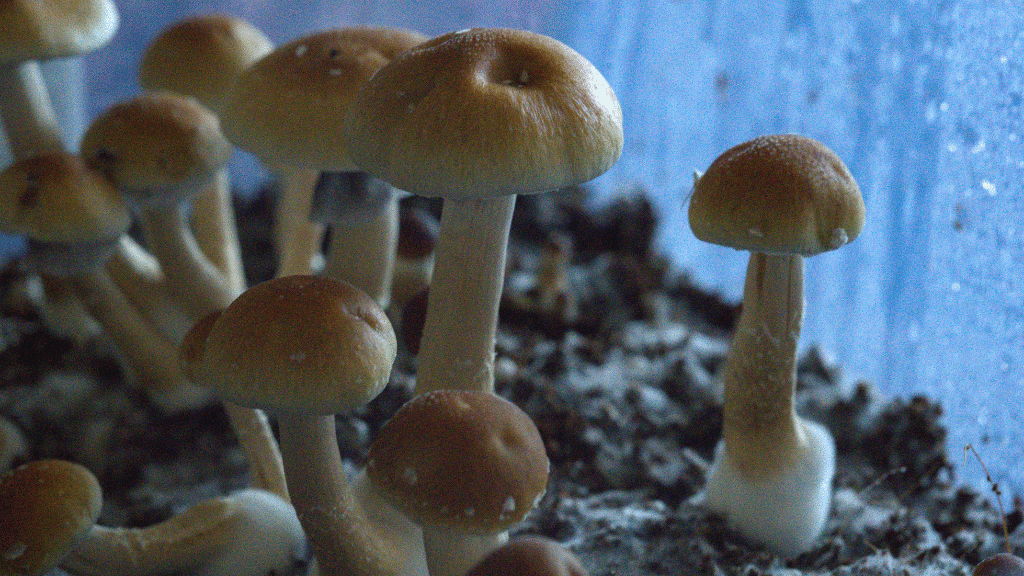
At this stage, the foil can be removed. Your mushrooms are ready to grow! You should add a casing layer that will help protect the mycelium and support the growing mushroom structures.
Combine about 3 parts to 1 vermiculite and water and add about ⅓ of an inch deep on top.
Now lightly mist the tub using a spray bottle, and close the lid! At this stage, your mushrooms will enjoy at least a little ambient light (but NEVER direct sunlight). A nearby fan is a good idea to promote air circulation. You're almost there: fruiting should begin in 5-14 days!
A rule of thumb is to harvest when the veil-like structure beneath the cap of the mushroom begins to burst apart. Continuing misting 1-2 times per day, depending on climate: the goal is to keep the tub slightly moist but not wet.
We hope this guide provided some valuable tips and helped demystify the process of turning perfectly legal microscopic spores into incredibly enjoyable magic mushrooms! Happy cultivating!

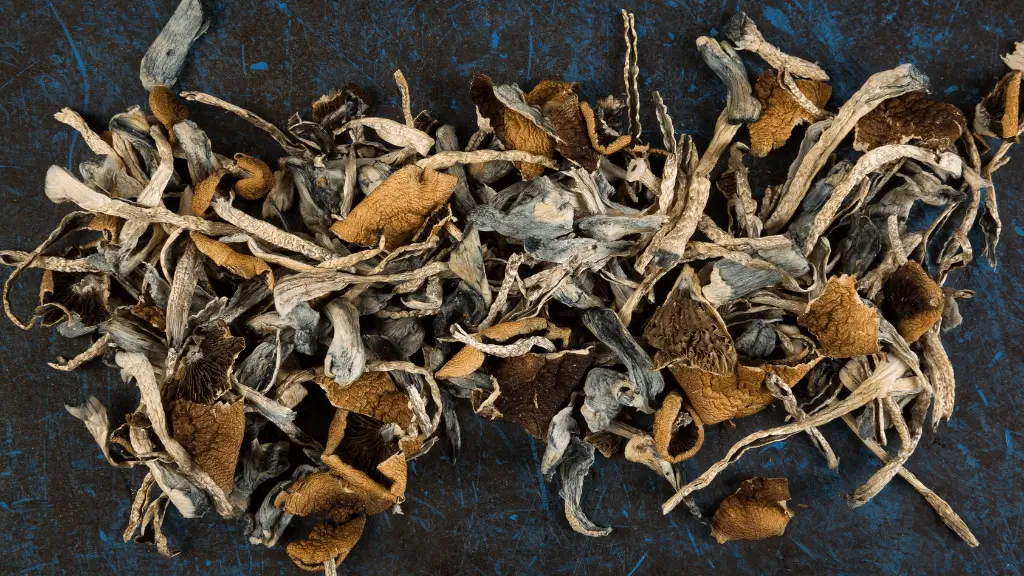
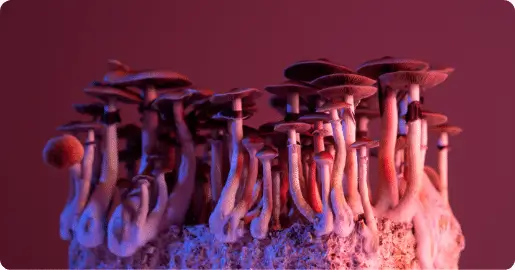


.png)
